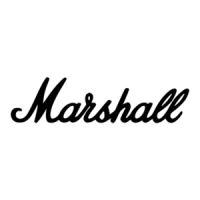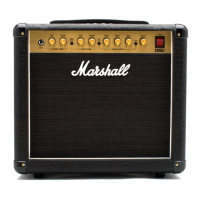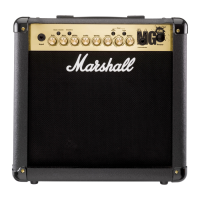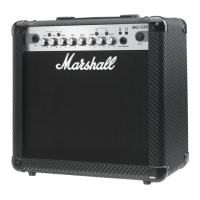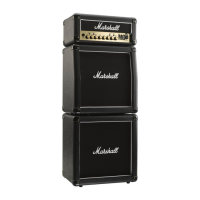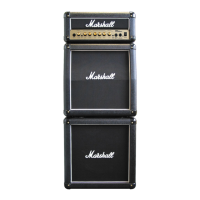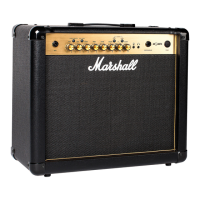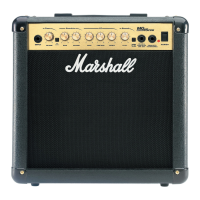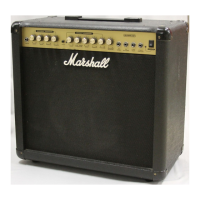Do you have a question about the Marshall Amplification MG50 GFX and is the answer not in the manual?
Crucial safety guidelines and warnings for operating the amplifier, including mains connection and setup.
Connects your guitar. Use a quality, screened cable for best results.
Adjusts the volume for the Clean Channel.
Toggles between Clean (green) and Overdrive (red) channels.
Sets the pre-amp signal level, controlling distortion amount.
Adjusts the volume for the Overdrive channel.
Modifies the mid-range frequency (body) for tone shaping.
For silent practice; connecting headphones mutes the internal speaker.
Connects external audio players for practice sessions.
Turns the amplifier on and off.
Connects your guitar. Use a screened cable for noise reduction.
Controls pre-amp signal level and distortion amount.
Selects between Clean (green) and Crunch (red) channels.
Adds warmth and low-end depth to the sound.
Selects between OD-1 (green) and OD-2 (red) channels.
Varies the amount of 'body' in your sound.
Adjusts brightness and tone edge; lower values soften sound.
Adds digital reverb (Studio/Spring) to channels, controlling amount.
Controls the volume of the selected channel.
Matches delay FX time to presses; switches between manual/preset modes.
Selects and adjusts digital effects like Chorus, Phaser, Flanger, Delay.
Stores current amp settings into a channel for recall.
Controls the overall master volume of the amplifier.
Connects external audio players for practice.
Connects an optional footcontroller for enhanced control.
For silent practice; mutes internal speaker when used.
Turns the amplifier on and off.
Explains channel switching, and differences between Preset/Manual modes.
Details how presets are stored and recalled in Preset mode, and manual mode.
Describes the types and controls for Reverb, FX, and Delay effects.
Guides on setting delay time and connecting audio players.
Usage of headphone socket and amplifier power functions.
Instructions to restore factory settings, warns about data loss.
Connects your guitar. Use a screened cable for noise reduction.
Controls pre-amp signal level and distortion amount.
Selects between Clean (green) and Crunch (red) channels.
Adds warmth and low-end depth to your sound.
Selects between OD-1 (green) and OD-2 (red) channels.
Varies the amount of body in your sound.
Adjusts brightness and tone edge; lower values soften sound.
Switches the reverb effect on and off.
Adds digital reverb (Studio/Spring) to channels, controlling amount.
Controls the volume of the selected channel.
Switches the FX section (FX and Delay) on and off.
Selects and adjusts digital effects: Chorus, Phaser, Flanger, Vibe, Octave.
Matches delay FX time to presses; LED flashes at selected time.
Controls signal for selectable delay types: Hi-Fi, Tape, Multi, Reverse.
Switches the external FX Loop on and off.
Controls the master volume of the amplifier.
Switches power amp damping; holds for manual/preset mode.
3.5mm socket for headphones or line out.
Stores current amp settings into a channel for recall.
Turns the amplifier on and off.
Connects the detachable mains lead. Check voltage rating.
Jack socket for connecting the optional footcontroller.
Connects internal or external speaker cabinet. Use non-screened cable.
Connects external audio players for practice.
Connects to the output of an external effects processor.
Connects to the input of an external effects processor.
Explains channel switching, and differences between Preset/Manual modes.
Details how presets are stored and recalled in Preset mode, and manual mode.
Describes the types and controls for Reverb, FX, and Delay effects.
Guides on setting delay time and connecting audio players.
Usage of headphone/line out sockets and power amp damping.
Details the FX Send/Return sockets for external effects processing.
Guidance on connecting extension cabinets; use non-screened leads.
Information on power switch operation and factory reset procedure.
Introduction to the optional footcontroller and its basic functions.
Storing front panel switches or amp presets to footswitch locations.
Understanding the digital display and LED status for footcontroller.
Accessing and using the built-in tuner via the footcontroller.
Crucial safety guidelines and warnings for operating the amplifier, including mains connection and setup.
Connects your guitar. Use a quality, screened cable for best results.
Adjusts the volume for the Clean Channel.
Toggles between Clean (green) and Overdrive (red) channels.
Sets the pre-amp signal level, controlling distortion amount.
Adjusts the volume for the Overdrive channel.
Modifies the mid-range frequency (body) for tone shaping.
For silent practice; connecting headphones mutes the internal speaker.
Connects external audio players for practice sessions.
Turns the amplifier on and off.
Connects your guitar. Use a screened cable for noise reduction.
Controls pre-amp signal level and distortion amount.
Selects between Clean (green) and Crunch (red) channels.
Adds warmth and low-end depth to the sound.
Selects between OD-1 (green) and OD-2 (red) channels.
Varies the amount of 'body' in your sound.
Adjusts brightness and tone edge; lower values soften sound.
Adds digital reverb (Studio/Spring) to channels, controlling amount.
Controls the volume of the selected channel.
Matches delay FX time to presses; switches between manual/preset modes.
Selects and adjusts digital effects like Chorus, Phaser, Flanger, Delay.
Stores current amp settings into a channel for recall.
Controls the overall master volume of the amplifier.
Connects external audio players for practice.
Connects an optional footcontroller for enhanced control.
For silent practice; mutes internal speaker when used.
Turns the amplifier on and off.
Explains channel switching, and differences between Preset/Manual modes.
Details how presets are stored and recalled in Preset mode, and manual mode.
Describes the types and controls for Reverb, FX, and Delay effects.
Guides on setting delay time and connecting audio players.
Usage of headphone socket and amplifier power functions.
Instructions to restore factory settings, warns about data loss.
Connects your guitar. Use a screened cable for noise reduction.
Controls pre-amp signal level and distortion amount.
Selects between Clean (green) and Crunch (red) channels.
Adds warmth and low-end depth to your sound.
Selects between OD-1 (green) and OD-2 (red) channels.
Varies the amount of body in your sound.
Adjusts brightness and tone edge; lower values soften sound.
Switches the reverb effect on and off.
Adds digital reverb (Studio/Spring) to channels, controlling amount.
Controls the volume of the selected channel.
Switches the FX section (FX and Delay) on and off.
Selects and adjusts digital effects: Chorus, Phaser, Flanger, Vibe, Octave.
Matches delay FX time to presses; LED flashes at selected time.
Controls signal for selectable delay types: Hi-Fi, Tape, Multi, Reverse.
Switches the external FX Loop on and off.
Controls the master volume of the amplifier.
Switches power amp damping; holds for manual/preset mode.
3.5mm socket for headphones or line out.
Stores current amp settings into a channel for recall.
Turns the amplifier on and off.
Connects the detachable mains lead. Check voltage rating.
Jack socket for connecting the optional footcontroller.
Connects internal or external speaker cabinet. Use non-screened cable.
Connects external audio players for practice.
Connects to the output of an external effects processor.
Connects to the input of an external effects processor.
Explains channel switching, and differences between Preset/Manual modes.
Details how presets are stored and recalled in Preset mode, and manual mode.
Describes the types and controls for Reverb, FX, and Delay effects.
Guides on setting delay time and connecting audio players.
Usage of headphone/line out sockets and power amp damping.
Details the FX Send/Return sockets for external effects processing.
Guidance on connecting extension cabinets; use non-screened leads.
Information on power switch operation and factory reset procedure.
Introduction to the optional footcontroller and its basic functions.
Storing front panel switches or amp presets to footswitch locations.
Understanding the digital display and LED status for footcontroller.
Accessing and using the built-in tuner via the footcontroller.
| Type | Solid State |
|---|---|
| Power Output | 50 Watts |
| Speaker Size | 12 inches |
| EQ Controls | Bass, Middle, Treble |
| Digital Effects | Yes |
| Digital Delay | Yes |
| Headphone Output | Yes |
| Channels | 2 |
| Controls | Gain, Volume, Bass, Middle, Treble, Reverb |
| Inputs | 1 x 1/4" Instrument |
| Outputs | 1 x 1/4" Line Out |
| Footswitch | Optional |
| Speaker | Custom 12" speaker |
